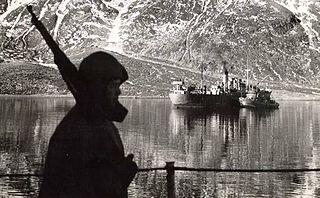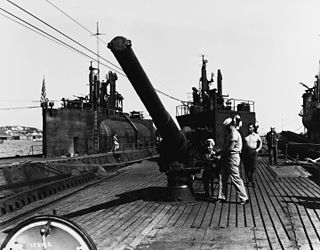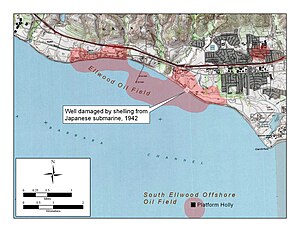
USS Monaghan (DD-354) was the last ship built of the Farragut-class destroyer design. She was named for Ensign John R. Monaghan. Monaghan was laid down on 21 November 1933 at the Boston Navy Yard, and launched on 9 January 1935. She was sponsored by Miss Mary F. Monaghan, niece of Ensign Monaghan, and commissioned on 19 April 1935. During the next few years Monaghan operated primarily in the North Atlantic, training US Navy personnel who served in World War II. Monaghan was present during the Pearl Harbor raid on 7 December 1941. She participated in the Battle of the Coral Sea and the Battle of Midway in 1942. Monaghan was sunk in Typhoon Cobra east of the Philippines in 1944.

USS Pensacola (CL/CA-24) was a cruiser of the United States Navy that was in service from 1929 to 1945. She was the lead ship of the Pensacola class, which the Navy classified as light cruisers in 1929, with the Pensacola herself originally designated as "CL-24." Under the terms of the Washington Naval Treaty, from 1931 on the class was re-classified as heavy cruisers, with the Pensacola being re-designated as "CA-24." The third Navy ship to be named after the city of Pensacola, Florida, she was nicknamed the "Grey Ghost" by Tokyo Rose. She received 13 battle stars for her service.

USS Grayback (SS-208), a Tambor-class submarine, was the first ship of the United States Navy to be named for the lake herring, Coregonus artedi. She ranked 20th among all U.S. submarines in total tonnage sunk during World War II, with 63,835 tons, and 24th in number of ships sunk, with 14. She was sunk near Okinawa on 27 February 1944. Her wreck was discovered in June 2019.

Mahan-class destroyers of the United States Navy were a series of 18 destroyers of which the first 16 were laid down in 1934. The last two of the 18, Dunlap and Fanning, are sometimes considered a separate ship class. All 18 were commissioned in 1936 and 1937. Mahan was the lead ship, named for Rear Admiral Alfred Thayer Mahan, an influential historian and theorist on sea power.

USS Piranha (SS-389/AGSS-389), a Balao-class submarine, was the only ship of the United States Navy to be named for the piranha. Piranha conducted six war patrols during World War II, receiving five battle stars. She was scrapped in 1970.

The American Theater was a theater of operations during World War II including all continental American territory, and extending 200 miles (320 km) into the ocean.

The Battle of Los Angeles, also known as the Great Los Angeles Air Raid, is the name given by contemporary sources to a rumored attack on the continental United States by Imperial Japan and the subsequent anti-aircraft artillery barrage which took place from late 24 February to early 25 February 1942, over Los Angeles, California. The incident occurred less than three months after the U.S. entered World War II in response to the Imperial Japanese Navy's surprise attack on Pearl Harbor, and one day after the bombardment of Ellwood near Santa Barbara on 23 February. Initially, the target of the aerial barrage was thought to be an attacking force from Japan, but speaking at a press conference shortly afterward, Secretary of the Navy Frank Knox called the purported attack a "false alarm". Newspapers of the time published a number of reports and speculations of a cover-up to conceal an actual invasion by enemy airplanes.
The Shelling of Newcastle was conducted by the Japanese submarine I-21 in the early hours of 8 June 1942. The bombardment followed the attack on Sydney Harbour on 31 May, and was conducted shortly after I-24 shelled the Eastern Suburbs of Sydney. During the attack I-21 fired 34 shells at Newcastle, including eight illumination rounds, but caused little damage. The Australian gunners at Fort Scratchley fired four shells at the submarine, but scored no hits.

I-17 was a Japanese B1 type submarine of the Imperial Japanese Navy which saw service during World War II. This long-range submarine cruiser spent the early months of the war in the eastern Pacific and was the first Axis ship to shell the continental United States. She later supported the Imperial Japanese Army in fighting around the Solomon Islands and remained active in the southwest Pacific until she was sunk in August 1943.

Ellwood Oil Field and South Ellwood Offshore Oil Field are a pair of adjacent, partially active oil fields adjoining the city of Goleta, California, about twelve miles (19 km) west of Santa Barbara, largely in the Santa Barbara Channel. A richly productive field in the 1930s, the Ellwood Oil Field was important to the economic development of the Santa Barbara area. A Japanese submarine shelled the area during World War II. It was the first direct naval bombardment of the continental U.S. since the Civil War, causing an invasion scare on the West Coast.

Marine Corps Air Station Santa Barbara was a United States Marine Corps air station that was located in Goleta, California 70 miles (113 km) north of Los Angeles during World War II. It was also known as the Goleta Air Station in the 1940s. Commissioned on 4 December 1942, the air station consisted of an airfield that had been built into the Goleta Slough and served as a training base for numerous squadrons before they deployed to support combat operations in the Pacific Theater. Later in the war, the station would serve as home to Marine squadrons that were trained to operate from aircraft carriers providing close air support for their fellow Marines on the ground. Following the surrender of Japan and the subsequent drawdown of forces that ensued, the air station closed its doors in 1946 and today its property is home to the Santa Barbara Municipal Airport and the campus of the University of California, Santa Barbara.

The Bombardment of Fort Stevens occurred in June 1942, in the American Theater and the Pacific Theater of World War II. The Imperial Japanese submarine I-25 fired on Fort Stevens, which defended the Oregon side of the Columbia River's Pacific entrance.

The Bombardment of Curaçao refers to a 1942 German naval bombardment of a Bullen Baai Company petroleum storage facility on the Dutch Caribbean island of Curaçao during World War II. The raids purpose was to ignite and destroy the petroleum held on Curaçao. This attempt failed and the German U-boat responsible was unsuccessfully engaged by a Dutch shore battery

The allied naval bombardments of Japan took place during the last weeks of the Pacific War in 1945, in which warships of the United States Navy, the Royal Navy and the Royal New Zealand Navy bombarded industrial and military facilities in Japan. Most of these bombardments were conducted by battleships and cruisers, and caused heavy damage to several of the targeted factories, as well as nearby civilian areas. A major goal of the attacks was to provoke the Japanese military into committing some of its reserve force of aircraft into battle. However, the Japanese did not attempt to attack the Allied bombardment forces, and none of the involved warships suffered any damage.
At the start of World War II, the Royal Navy was the strongest navy in the world, with the largest number of warships built and with naval bases across the globe. It had over 15 battleships and battlecruisers, 7 aircraft carriers, 66 cruisers, 164 destroyers and 66 submarines. With a massive merchant navy, about a third of the world total, it also dominated shipping. The Royal Navy fought in every theatre from the Atlantic, Mediterranean, freezing Northern routes to Russia and the Pacific Ocean.

The 14 cm/40 11th Year Type naval gun was the standard surface battery for Japanese submarine cruisers of World War II. Most carried single guns, but Junsen type submarines carried two. Japanese submarines I-7 and I-8 carried an unusual twin mounting capable of elevating to 40°. The appended designation 11th year type refers to the horizontal sliding breech block on these guns. Breech block design began in 1922, or the eleventh year of the Taishō period in the Japanese calendar. The gun fired a projectile 14 centimeters (5.5 in) in diameter, and the barrel was 40 calibers long.

California during World War II was a major contributor to the World War II effort. California's long Pacific Ocean coastline provided the support needed for the Pacific War. California also supported the war in Europe. After the Japanese attack on Pearl Harbor on December 7, 1941, most of California's manufacturing was shifted to the war effort. California became a major ship builder and aircraft manufacturer. Existing military installations were enlarged and many new ones were built. California trained many of the troops before their oversea deployment. Over 800,000 Californians served in the United States Armed Forces. California agriculture, ranches and farms were used to feed the troops around the world. California's long coastline also put the state in fear, as an attack on California seemed likely. California was used for the temporary and permanent internment camps for Japanese Americans. The population grew significantly, largely due to servicemen who were stationed at the new military bases/training facilities and the mass influx of workers from around the U.S. in the growing defense industries. With all the new economy activity, California was lifted out of the Great Depression. Over 500,000 people moved to California from other states to work in the growing economy. California expanded its oil and mineral production to keep up with the war demand.
The Gaviota Coast in Santa Barbara County, California is a rural coastline along the Santa Barbara Channel roughly bounded by Goleta Point on the south and the north boundary of the county on the north. This last undeveloped stretch of Southern California coastline consists of dramatic bluffs, isolated beaches and terraced grasslands.

The SS Agwiworld was a tanker ship that was able to evade an attack off the coast of California in the early days of World War II. Agwiworld was built by Sun Shipbuilding in Chester, Pennsylvania on the Delaware River. Agwiworld's keel was laid down on July 28, 1920. The vessel was launched on December 22, 1920, and delivered on January 19, 1921. Agwiworld was owned and operated by Richfield Oil Company and homeport was Los Angeles, California.

The SS Samoa was a 1,997-ton cargo ship that was able to escape an attack off the coast of California in the early days of World War II. The Samoa was built under a United States Shipping Board (USSB) contract in 1918 as the SS Muerthe, but was launched as the USS Lake Pepin, named after Lake Pepin, by the McDougall Duluth Shipbuilding Company of Duluth, Minnesota measured at 3,600 tons deadweight. She had a triple expansion engine steam engine with 1,250 horsepower (930 kW), a 251-foot (77 m) length, 43.5-foot (13.3 m) beam, a draft of 17 feet 8+1⁄2 inches (5.398 m), a top speed of 9.25 knots. The vessel had a crew of 52, with the hull # 9 and O.N.ID # 21699. The USS Lake Pepin was owned and operated by the United States Navy, commissioned at Montreal, Quebec, Canada on 4 September 1918. For World War I she was fitted with one 3"/50 caliber gun. The Navy put her in Naval Overseas Transportation Service as a coal carrier traveling between the United Kingdom and France as a United States Navy Temporary auxiliary ship. Her coal service ended in May 1919. In June 1919 she returned to the US with a cargo of World War I vehicles and weapons and unused ammunition. The US Navy decommissioned the Lake Pepin on 18 June 1919. In 1923 she was, renamed Samoa purchased and operated by the Hammond Lumber Company. In 1936 she was sold to the Wheeler Logging Company of Portland, Oregon. In February of 1941 she was sold to W. A. Schaefer Company.
Referenced briefly (p.103 and others) in the Three Investigators mystery, "The Secret Of Shark Reef", written by William Arden (Dennis Lynds). Published in paperback by Random House, 1979.

















